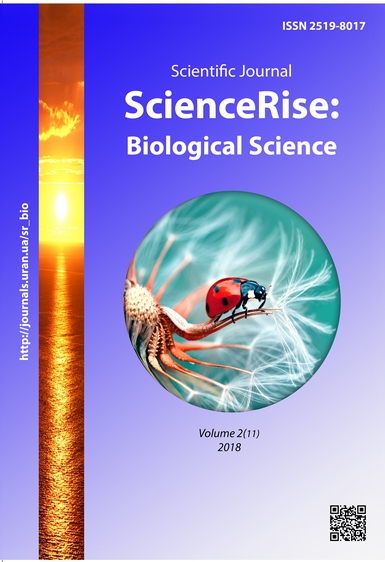Antibiofilm activity of azithromycin against Staphylococcus epidermidis
DOI:
https://doi.org/10.15587/2519-8025.2018.128653Keywords:
biofilms, Staphylococcus, antibiotics, mechanisms of effect, adhesion, hydrophobic behavior, red Kongo, РІАAbstract
The aim of the study was to establish specific activity of azithromycin against the biofilm, formed by S. epidermidis and several aspects of the mechanism of the effect of this preparation.
The ability of Staphylococcus to adhesion on abiotic surfaces (polysterene plane-tables) was determined by Christensen methodology (fixation by 96 % ethanol, coloration by 0.1 % solution of gentian violet). The antibiofilm activity of azithromycin was investigated by the method of sorption of gentian violet on biofilm structures with further desorption in 96 % ethyl alcohol. The hydrophobic behavior of a strain was investigated using BATH-test in the two-phased system with ethylacetate. For determining the ability of epidermal Staphylococcus to producing polysaccharide intercellular adhesin (PIA) there was used Luria-Bertani (LB) agarized medium with 0,08 % red Kongo.
The study of the antibiofilm activity of azithromicin demonstrated that the antibiotic disturbs fixation to the abiotic surface and film formation of S. epidermidis 2265 in concentration 5.0 MIC, but doesn’t have the inhibiting effect of the formed 1-day film. It was established, that a clinical strain of epidermal Staphylococcus S. epidermidis 2265 has no ability to production of polysaccharide intercellular adhesion (РІА).
The studies demonstrated that the effect of azithromycin is directed on the primary stages of biofilm formation. It was established, that the mechanism of the effect of the antibiotic on biofilm bacteria is not conditioned by a change of the hydrophobic behavior of the bacterial surface and PIA production
References
- Eroshenko, D. V. (2015). Vliyanie faktorov vneshney sredy na pervye etapy obrazovaniya bioplenok bakteriyami Staphylococcus epidermidis. Perm, 137.
- Kustos, T., Kustos, I., Kilar, F., Rappai, G., Kocsis, B. (2003). Effect of Antibiotics on Cell Surface Hydrophobicity of Bacteria Causing Orthopedic Wound Infections. Chemotherapy, 49 (5), 237–242. doi: 10.1159/000072447
- Oliveira, R., Azeredo, J., Teixeira, P., Fonseca, А. P. (2001). The role of hydrophobicity in bacterial adhesion. BioLine, 11–22.
- Rohde, H., Burandt, E. C., Siemssen, N., Frommelt, L., Burdelski, C., Wurster, S. et. al. (2007). Polysaccharide intercellular adhesin or protein factors in biofilm accumulation of Staphylococcus epidermidis and Staphylococcus aureus isolated from prosthetic hip and knee joint infections. Biomaterials, 28 (9), 1711–1720. doi: 10.1016/j.biomaterials.2006.11.046
- Kozlova, L. V. (2012). Azitromycin efficacy in treatment of pediatric out-of-hospital infections. Current Pediatrics, 11 (1), 51–55. doi: 10.15690/vsp.v11i1.132
- Maydannik, V. G., Sribnaya, V. D. (2013). Azitromitsin: antibakterial'nye i neantibakterial'nye effekty. Mezhdunarodnyy zhurnal pediatrii, akusherstva i ginekologii, 3 (1), 64–74.
- Nedashkivska, V. V., Dronova, M. L., Vrynchanu, N. O. (2016). Bioplivky ta yikh rol v infektsiinykh zakhvoriuvanniakh. Ukrainskyi naukovo-medychnyi molodizhnyi zhurnal, 4, 10–19.
- Kovalenko, V. N., Viktorov, A. P. (Eds.) (2010). Kompendium 2010 – lekarstvennye preparaty. Kiev: Morion, 2240.
- Christensen, G. D., Simpson, W. A., Younger, J. A., Baddour, L. M., Barrett, F. F., Melton, D. M. et. al. (1985). Adherence of coagulase-negative staphylococci to plastic tissue cultures: a quantitative model for the adherence of staphylococci to medical devices. Journal of Clinical Microbiology, 22 (6), 996–1006.
- O'Toole, G. A. (2011). Microtiter dish biofilm formation assay. Journal of Visualized Experiments, 47, 2437. doi: 10.3791/2437
- Romanova, Yu. M., Smirnova, T. A., Andreev, A. L., Ilina, T. S., Didenko, L. V., Gintsburg, A. L. et. al. (2006). Obrazovanie bioplenok – primer «sotsial'nogo» povedeniya bakteriy. Mikrobiologiya, 75 (4), 556–661.
- Bellon-Fontaine, M.-N., Rault, J., van Oss, C. J. (1996). Microbial adhesion to solvents: a novel method to determine the electron-donor/electron-acceptor or Lewis acid-base properties of microbial cells. Colloids and Surfaces B: Biointerfaces, 7 (1-2), 47–53. doi: 10.1016/0927-7765(96)01272-6
Downloads
Published
How to Cite
Issue
Section
License
Copyright (c) 2018 Nataliia Hrynchuk, Nina Vrynchanu, Larysa Stepura

This work is licensed under a Creative Commons Attribution 4.0 International License.
Our journal abides by the Creative Commons CC BY copyright rights and permissions for open access journals.
Authors, who are published in this journal, agree to the following conditions:
1. The authors reserve the right to authorship of the work and pass the first publication right of this work to the journal under the terms of a Creative Commons CC BY, which allows others to freely distribute the published research with the obligatory reference to the authors of the original work and the first publication of the work in this journal.
2. The authors have the right to conclude separate supplement agreements that relate to non-exclusive work distribution in the form in which it has been published by the journal (for example, to upload the work to the online storage of the journal or publish it as part of a monograph), provided that the reference to the first publication of the work in this journal is included.









